"Hope needs an ally. The ally of hope is the imagination. Imagination. Imagination to the rescue." - Roberto Unger
Don't wanna be here? Send us removal request.
Text
Tony Benn on the Levellers
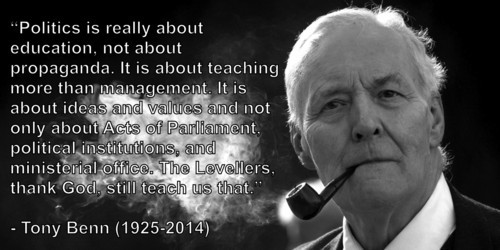
"About Levellers Day" (From: levellersday.wordpress.com)
In 1975, members of the WEA Oxford Industrial Branch went to Burford to reclaim a piece of history that seemed to be missing from the school books. They held a meeting in remembrance of the Leveller soldiers. The following year, Tony Benn came and read in the church and in each succeeding year, people have come to Burford on the Saturday nearest to 17 May, debated, held a procession, listened to music and remembered the Levellers and the importance of holding on to ideals of justice and democracy.
"Set my people free" (The Guardian, 13th May 2001)
Their message was spelled out very clearly in 'An Agreement of the Free People of England' which outlined a new and democratic constitution for Britain. It was published on 1 May 1649 while the leaders of the Levellers were imprisoned in the Tower of London, and the key words are these: 'We, the free people of England, agree to ascertain our government to abolish all arbitrary power and to set bounds and limits both to our supreme and all subordinate authority and remove all known grievances.'
They also argued for universal state schools and hospitals to be provided at public expense and anticipated the welfare state by 300 years.
"The Levellers and the Tradition of Dissent" (BBC History, 2011):
For politics is really about education, not about propaganda. It is about teaching more than management. It is about ideas and values and not only about Acts of Parliament, political institutions, and ministerial office. The Levellers, thank God, still teach us that.
0 notes
Text
Green farms could cut agricultural emissions by 90%

"Clean farms can save the climate" (Deutsche Welle, 15th May 2014):
Annual carbon emissions from global agriculture can be reduced by as much as 90 percent by 2030, according to a new report released by Climate Focus and California Environmental Associates. That would be the equivalent of getting rid of all the cars in the world. The study highlights a range of strategies to mitigate carbon production in agriculture.
"Strategies for Mitigating Climate Change in Agriculture" (Climate and Land Use Alliance, April 2014):
Agriculture contributes substantially to global climate change. The sector accounts for roughly a fifth of greenhouse gas (GHG) emissions when one considers the full life cycle of production including agriculture’s role in deforestation. This is a massive number, comparable in scale to the transportation sector. Further, this ratio can be even higher in developing countries where the agriculture and forestry sectors together often account for a majority of total emissions. Yet, historically, climate negotiators and policy makers have paid relatively little attention to the agricultural sector in the global effort to slow climate change.
A constructive debate on agriculture and climate change is hampered by a false dichotomy between food security and environmental health. Civil society often approaches agriculture with an overarching mission of either improving food security and strengthening smallholder livelihoods or reducing the environmental degradation caused by agricultural systems. The option of supporting productive, low-emissions agricultural systems often falls through the cracks of these agendas. There is also little discussion about the opportunities provided by reducing emissions through shifting diets as well as the reduction of food loss and waste. The specter of mitigation practices that risk reducing yields may be preventing a useful integration of the food security and livelihoods agenda with that of the climate and environmental community. Given the likely impacts of climate change on poor and vulnerable communities, we cannot afford to approach agriculture from these silos any longer.
0 notes
Text
Germany meets 74% of electricity needs with renewables

"Germany Sets New Record, Generating 74 Percent Of Power Needs From Renewable Energy" (Think Progress, 13th May 2014)
On Sunday, Germany’s impressive streak of renewable energy milestones continued, with renewable energy generation surging to a record portion — nearly 75 percent — of the country’s overall electricity demand by midday. With wind and solar in particular filling such a huge portion of the country’s power demand, electricity prices actually dipped into the negative for much of the afternoon, according to Renewables International.
"Climate Change and Energy" (European Greens, Spring 2014)
We want a Europe that gets 20% of its energy from renewable sources by 2020. We want to see binding 2030 targets for carbon emissions agreed to, and for Europe to rely fully on renewable energies by 2050.
0 notes
Text
UK gardeners plant record number of bee-friendly flowers
"Flower power takes hold again as gardeners rally round the endangered bumblebee" (The Independent, 18th April 2014):
Gardeners are planting record numbers of flowers rich in nectar as the public throws itself firmly behind the plight of the endangered bumblebee.
Sales of lavender, sunflowers and dahlias have risen significantly this year following reports of a dramatic decline in the population of honey, bumble and other species of bees, and the damage this poses to food supplies and the environment at large.
Bees and other pollinators fertilise three-quarters of the planet’s food crops and their numbers have been greatly reduced in recent years as disease, pesticides and the loss of flower-rich habitats have taken their toll.
Matthew Oates, the National Trust’s specialist on nature and wildlife, has noticed a rise in gardening for the benefit of bees.
“Bee-friendly gardening is getting big. It’s already helping and I think it will help enormously in the longer term. So much of wildlife lies in people’s minds and the bees’ plight has really captured the public’s imagination.”
3 notes
·
View notes
Text
UK citizens support four day work week, according to new poll
"Introduce a four day week, say public" (YouGov, 16th April 2014):
57% support introducing a four day working week in the UK – and 71% say it would make Britain happier [...]
In 2008 the US state of Utah introduced a four day week, and nearly two-thirds of employees said it made them more productive.
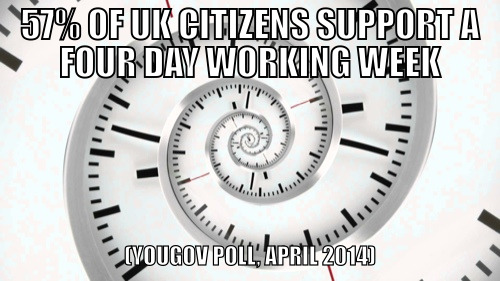
0 notes
Text
Europe could save 10,000 lives and create 76,000 jobs by promoting cycling in cities
"Jobs in green and healthy transport" (World Health Organisation Regional Office for Europe, 14th April 2014):
It was estimated that about 76 600 jobs could be created if selected cities achieved the same modal share of cycling as the Danish capital, Copenhagen. Additionally, about 10 000 deaths could be avoided each year thanks to the health benefits of cycling. These figures are likely to be underestimates, as they correspond to only one city per country and to only a small proportion of the jobs that could contribute to making transport greener, safer and more efficient.
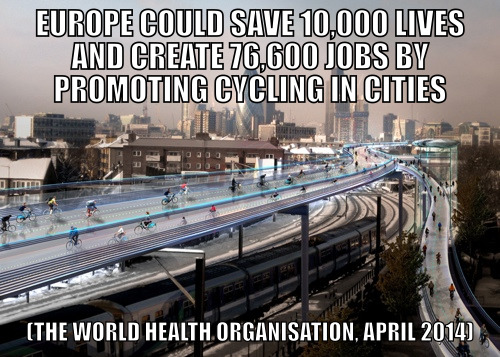
0 notes
Text
Governments catalyse innovation in ways that the private sector can't
"Innovation: The Government Was Crucial After All" (The New York Review of Books, 24th April 2014):
Mazzucato’s criticism of US innovation strategies goes deeper than the lack of adequate funding. She makes one of the most convincing cases I have seen for the value and competence of government itself, and for its ability to do what the private sector simply cannot. It is not only, as economists argue, a matter of reducing the risk of research and innovation for private enterprise. She argues that government efforts are the source of new technological visions for the future, and—very persuasively—she cites the innovations of the past sixty years to make her case.
"The Most Dangerous Word in Tech" (The New York Times, 12th April 2014):
“What made the iPhone ‘smart’ — GPS, touch screens, Siri, the Internet — was started by the government,” said Ms. Mazzucato. “The National Institutes of Health is responsible for creating the most revolutionary drugs.” Her recent book, The Entrepreneurial State, is about contributions the government has made to innovations Silicon Valley claims as its own.
“The government doesn’t just fix markets by leaving capital to do its thing, it creates them,” she said.
That is a fine thing, she added, except returns are increasingly going to entrepreneurs and their venture capital backers. As a result, basic government-backed research is increasingly underfunded, she said, and the broader society does not benefit from the investment made with their taxes.
Another problem with our current view of innovation is its culture of speed, and an increasing love affair with rapid change. “Venture capital has become increasingly short-term,” Ms. Mazzucato said. “Innovation takes 15 to 20 years in key technologies.”
#innovation#government#institutionalimagination#institutions#state#publicsectorinnovation#publicsector
0 notes
Text
The case against cars in cities
"The Case Against Cars in 1 Utterly Entrancing GIF" (The Atlantic, 18th November 2013):
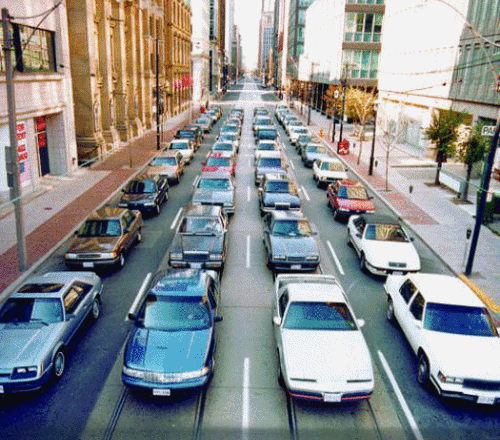
"Paris in the smog" (The Economist, 17th March 2014):
The government began by trying to encourage Parisians and those in the nearby suburbs to use their cars and motorbikes less often. The city’s extensive public-transport network was made free from March 14th, and extra trains were put into circulation. The speed limit was also reduced on certain roads. A more drastic attempt to enforce a reduction in car use came into place today, and will be continued tomorrow if necessary by allowing cars and motorbikes with even-numbered registration plates on the roads. Some 700 policemen were manning 60 control points around the capital to enforce the ban, the breach of which carries a €22 ($30) fine.
"Can a city really ban cars from its streets?" (BBC Future, 4th February 2014)
The German city of Hamburg has announced plans to become car-free within the next two decades. It is an ambitious idea, but city officials obviously feel that the personal motorcar does not fulfill a function that walking, biking and taking public transport cannot.
The goal of Hamburg’s project is to replace roads with a "gruenes netz" or a green network of interconnected open areas covering 40% of the city. According to the official website, parks, playgrounds, sports fields, allotments and cemeteries will be connected to form a network, which will allow people to navigate through the city without the use of cars.
Banishing the car from urban areas is becoming a common trend in many European cities. London imposes a “congestion charge” on private vehicles entering the city centre during peak hours. The Danish capital Copenhagen is building bicycle superhighways radiating out from the city centre.
"‘No place for cars’ in cities of the future" (The Times, 15th July 2013):
There will be a widespread ban on cars in London within the next 20 years, according to one of Britain’s leading architects, who has called for cities to be designed for pedestrians and cyclists rather than for traffic.
The prediction from Lord Rogers of Riverside — who was behind the Pompidou Centre in Paris, the National Assembly Building in Cardiff and the Lloyd’s Building in London — comes as cities around the country consider restricting access for cars in their centres.
Lord Rogers predicted that small electric vehicles would become commonplace across the country and said that increasing the number of cyclists will solve the capital’s congestion problems. “By the year 2033 — my 100th birthday — you’re looking at a widespread ban on cars, certainly in the centre of town,” he said. “There will be a major change in the power and form of cars everywhere, with electric rickshaws and devices that resemble Segways a common sight.”
12 notes
·
View notes
Text
Former "fracking village" aims to meet 100% of energy needs with community-owned renewable energy co-operative
"Balcombe: 'now everyone's working towards the same goal'" (Channel 4 News, 16th April 2014):
Made famous by a high-profile anti-fracking protest camp last year, the Sussex village of Balcombe is now embarking on a renewable energy project that villagers say is promoting community cohesion.
When energy company Cuadrilla - a pioneer of fracking in the UK - moved in to Balcombe last summer to drill an exploratory well to see if oil could be produced from the site, a noisy protest began against the operation.
But the weeks of demonstrations, which at some points were attracting environmentalists from across the country, left the village divided.
Balcombe resident Felix Carmichael told Channel 4 News: "the fracking / anti-fracking campaigns really broke up a quiet little village."
The last protestors were evicted in November 2013, but tensions were still evident in December, when Kathryn McWhirter, of the Frack Free Balcombe Residents Association, told the BBC: "the village is absolutely divided - we put notices up and seconds later they're taken down."
Some villagers say a project to bring renewable energy is healing those rifts.
The backers of the Repower Balcombe Co-operative hope to supply the equivalent 100 per cent of Balcombe's electricity demand through community owned and locally generated energy.
A meeting to propose the idea attracted some 50 locals - in a village of 760 homes. Now phase one of the project - to install solar panels that can deliver 250kwh of the target power - is underway.
0 notes
Text
Close an airport, start a new green neighbourhood
"An alternative vision for the Royal Docks" (New Economics Foundation, 17th April 2014):
London City Airport takes up precious land in the heart of London, but benefits mainly a wealthy few. The ideas of local people and sustainable city experts come together in this vibrant illustration of what the Royal Docks could become if the airport was closed: a world leading example of a strong, healthy, environmentally friendly and fun neighbourhood.
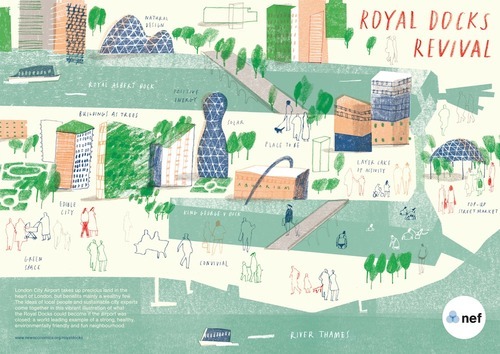
0 notes
Text
European freelancers form a movement
"Why it’s time for freelancers to pipe up and get organised" (RSA Blogs, 2nd April 2014):
This year may be remembered as the start of a new chapter in employment politics. Across Europe, freelancers are getting organized into a cohesive movement, and are making demands of governments and employers.
At the fore of this movement is the Freelancers Europe campaign, which is rallying independent workers to sign a five-point manifesto ahead of the European Parliament elections. The campaign – operated mostly online, with events and outreach in coworking spaces – aims to collect a modest 10,000 supporters in its initial outing. There are plans for future larger actions that will demonstrate the size and strength of Europe’s freelancing class, which is estimated to be almost 9 million strong.
0 notes
Text
How to cut a city's energy consumption by 25%
"How to cut a city's energy consumption by 25%" (The Green European Journal, 15th April 2014):
The Greens have been a part of the government of the Region of Brussels for ten years and in that time much progress has been made in the area of food, water, and urban renovation policy. However, our main success is having reached the objective that we established at the outset: decrease energy consumption and improve the energy efficiency of buildings. Indeed, between 2004 and 2011, we slashed average per capita energy consumption by 25%.
We did this by concentrating on:
Incentivising: we published a call for tender for “exemplary buildings,” i.e., that were highly energy efficient and environmentally sound. It was a great success and a total of 621.000 m2 of buildings were built.
Legislating: starting in 2015, all new buildings in Brussels must be passive.
Informing: we founded six Energy Information Points where the citizens of Brussels can turn to get information and seek advice on how to improve the insulation of their homes and boost renewable energy sources.
Our efforts are focused on older buildings (through financial incentives for insulation and renovation for better energy efficiency, thanks to insistence by the Greens the total amounts for these incentives were significantly increased) and new constructions.
As part of a project to get the population involved, major investment was made to renovate social housing. Public space, green space and local facilities were refurbished through Contracts for a Sustainable Neighborhood.
0 notes
Text
Life beyond work
"When the French clock off at 6pm, they really mean it" (The Guardian, 9th April 2014):
Après noticing that the ability of bosses to invade their employees' home lives via smartphone at any heure of the day or night was enabling real work hours to extend further and further beyond the 35-hour week the country famously introduced in 1999, workers' unions have been fighting back. Now employers' federations and unions have signed a new, legally binding labour agreement that will require employers to make sure staff "disconnect" outside of working hours.
"Sweden to trial six-hour public sector workday" (The Independent, 9th April 2014):
A city council in Sweden is set to cut the number of hours its staff members work down to just six – while keeping them on full pay.
The controversial economic experiment will see municipal workers in Gothenburg, the country’s second-largest city, become guinea pigs in a trial lasting at least one year.
The council’s ruling coalition of left-wing Social Democrat and Green parties has proposed reducing one department to 30-hour working weeks while keeping another unchanged as a control.
“We think it's time to give this a real shot in Sweden,” deputy mayor Mats Pilhem told the Swedish edition of The Local.
"Reduce the Workweek to 30 Hours" (The New York Times, 9th March 2014):
We used to send children down mines, sack women when they got married and expect workers to put in 12-hour day, six days a week. For more than 200 years, we have associated better working conditions and shorter hours with human progress. An average workweek of 40 hours nowadays looks old fashioned and backward.
Workers on shorter hours are under less stress, get sick less often and are more loyal. Plus a shorter workweek is better for the environment.
We need a slow but steady move toward a 30-hour week for all workers. This will help solve a lot of connected problems: overwork, unemployment, overconsumption, high carbon emissions, low well-being, entrenched inequalities and the lack of time to live sustainably, to care for each other and simply to enjoy life.
People working shorter hours generally have a smaller ecological footprint. If you are tied to the workplace for 40-plus hours, you don’t have much time for the rest of your life. So things have to speed up. You travel by plane or car instead of train, foot or bike. Convenience-driven consumption takes a heavy toll on the environment.
Some say it can’t be done because wages are too low. So let’s raise wages. No one should have to work long hours just to get by. Some say it’s uncompetitive. But there’s no match between average working hours and the strength of a country’s economy. The Netherlands and Germany have a shorter workweek than the United States and Britain. But the Dutch and German economies are stronger, not weaker. Workers on shorter hours tend to be more productive hour-for-hour. They are under less stress, they get sick less often and they make a more loyal and committed workforce.
We ended slavery, built the railways and won votes for women. All these once seemed impossible. We can do the same for working hours. It’s only a matter of time.
0 notes